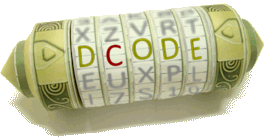Tool to decrypt/encrypt as a Knight Templar. Knights Templars Ciphers is a substitution code replacing letters by symbols from the Maltese Cross, icon of Order of the Temple.
Templars Cipher - dCode
Tag(s) : Symbol Substitution
dCode is free and its tools are a valuable help in games, maths, geocaching, puzzles and problems to solve every day!
A suggestion ? a feedback ? a bug ? an idea ? Write to dCode!
Templars Cipher
Knights Templar Decoder
Knights Templar Encoder
Answers to Questions (FAQ)
What is the knights templar cipher? (Definition)
The Templar cipher is a substitution encryption system historically used by the (Knights) Templars (a Christian military order) in the Middle Ages to protect their communications.
The Templar code uses 25 symbols (pieces of the Maltese Cross) to represent the letters of the alphabet.
How to encrypt using Knights Templar cipher?
To encode a message like the Templars, replace each letter with the corresponding Templar symbol:
| A | .png) | B | .png) | C | .png) | D | .png) | E | .png) |
|---|---|---|---|---|---|---|---|---|---|
| F | .png) | G | .png) | H | .png) | I | .png) | K | .png) |
| L | .png) | M | .png) | N | .png) | O | .png) | P | .png) |
| Q | .png) | R | .png) | S | .png) | T | .png) | U | .png) |
| V | .png) | W | .png) | X | .png) | Y | .png) | Z | .png) |
| dCode.fr | |||||||||
The letter J is missing, it is customary to replace it with the letter I.
Some sources have the letters L and K swapped (see FAQ).
The numbers (0-9) have no symbol and are not replaced.
How to decrypt using Knights Templar cipher?
How to recognize Templars ciphertext?
The ciphered message is made from symbols with angles, triangles, with at most one dot per symbol.
The message has at most 25 distinct characters.
Any reference to the Knights Templars or Solomon's Militia (with a reputation of killers/assassins) is a clue.
The Pig-Pen cipher and Rosicrucian ciphers are similar.
Why is the J letter missing?
The letter J did not exist when encryption was invented, it was a graphic variant of the letter I, and the J only appeared around the 16th century.
Why are the letters K and L sometimes swapped?
Several writings refer to the Templar alphabet, the main one is The Knights Templars by A. Bothwell-Gosse. Pages 89 and 90 the letter K points to the left and the letter L upwards.
Another source is Histoire des Sectes Religieuses by H. Grégoire (1828). Volume II, page 428, the letter K points to the left and the letter L to the top.
The code may have evolved, but it is likely that the inversions of K and L are errors.
Who created the Templar Cipher?
The cipher was created by the Templars, the name given to members of the Order of the Temple, a religious and military group (chivalry) from the Middle Ages, known for his crusades.
When was the Templars Cipher invented?
No one knows when or how this system appeared, but traces of the existence of the Templar code go back to handwritten letters from the 12th or 13th century.
Source code
dCode retains ownership of the "Templars Cipher" source code. Any algorithm for the "Templars Cipher" algorithm, applet or snippet or script (converter, solver, encryption / decryption, encoding / decoding, ciphering / deciphering, breaker, translator), or any "Templars Cipher" functions (calculate, convert, solve, decrypt / encrypt, decipher / cipher, decode / encode, translate) written in any informatic language (Python, Java, PHP, C#, Javascript, Matlab, etc.) or any database download or API access for "Templars Cipher" or any other element are not public (except explicit open source licence). Same with the download for offline use on PC, mobile, tablet, iPhone or Android app.
Reminder: dCode is an educational and teaching resource, accessible online for free and for everyone.
Cite dCode
The content of the page "Templars Cipher" and its results may be freely copied and reused, including for commercial purposes, provided that dCode.fr is cited as the source (Creative Commons CC-BY free distribution license).
Exporting the results is free and can be done simply by clicking on the export icons ⤓ (.csv or .txt format) or ⧉ (copy and paste).
To cite dCode.fr on another website, use the link:
In a scientific article or book, the recommended bibliographic citation is: Templars Cipher on dCode.fr [online website], retrieved on 2025-10-27,
- Knights Templar Decoder
- Knights Templar Encoder
- What is the knights templar cipher? (Definition)
- How to encrypt using Knights Templar cipher?
- How to decrypt using Knights Templar cipher?
- How to recognize Templars ciphertext?
- Why is the J letter missing?
- Why are the letters K and L sometimes swapped?
- Who created the Templar Cipher?
- When was the Templars Cipher invented?
